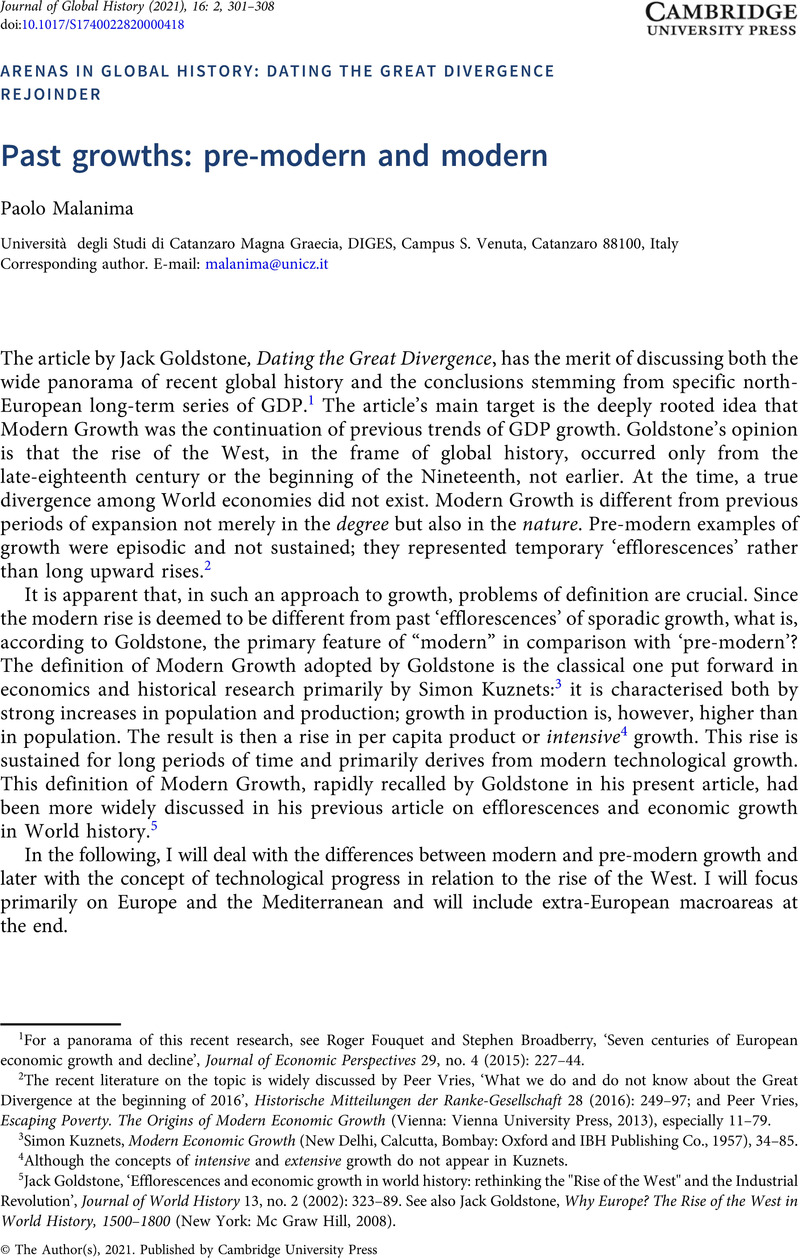Article contents
Past growths: pre-modern and modern
Published online by Cambridge University Press: 23 June 2021
Abstract

- Type
- Rejoinder
- Information
- Copyright
- © The Author(s), 2021. Published by Cambridge University Press
References
1 For a panorama of this recent research, see Roger Fouquet and Stephen Broadberry, ‘Seven centuries of European economic growth and decline’, Journal of Economic Perspectives 29, no. 4 (2015): 227–44.
2 The recent literature on the topic is widely discussed by Peer Vries, ‘What we do and do not know about the Great Divergence at the beginning of 2016’, Historische Mitteilungen der Ranke-Gesellschaft 28 (2016): 249–97; and Peer Vries, Escaping Poverty. The Origins of Modern Economic Growth (Vienna: Vienna University Press, 2013), especially 11–79.
3 Simon Kuznets, Modern Economic Growth (New Delhi, Calcutta, Bombay: Oxford and IBH Publishing Co., 1957), 34–85.
4 Although the concepts of intensive and extensive growth do not appear in Kuznets.
5 Jack Goldstone, ‘Efflorescences and economic growth in world history: rethinking the "Rise of the West" and the Industrial Revolution’, Journal of World History 13, no. 2 (2002): 323–89. See also Jack Goldstone, Why Europe? The Rise of the West in World History, 1500–1800 (New York: Mc Graw Hill, 2008).
6 Carlos Álvarez-Nogal and Leandro Prados De La Escosura, ‘The rise and fall of Spain (1270–1850)’, Economic History Review 66, no. 1 (2013): 1–37.
7 Nuno Palma and Jaime Reis, ‘From convergence to divergence: Portuguese economic growth, 1527–1850’, Journal of Economic History 79, no. 2 (2019): 1–30.
8 Ulrich Pfister, ‘Economic growth in Germany, 1500–1850’ (paper presented at the conference on quantifying long run economic development, Venice, 22–24 March 2011).
9 Leonardo Ridolfi, ‘The French economy in the longue durée. A study on real wages, working days and economic performance from Louis IX to the Revolution (1250–1789)’ (PhD diss., IMT School for Advanced Studies Lucca, Lucca, Italy, 2016).
10 Marian Malinowski and Jan Luiten Van Zanden, ‘Income and its distribution in preindustrial Poland’, Cliometrica 11, no. 3 (2017): 375–404.
11 The average of rising wages in England and the declining wages in Italy draws rather well a European average for the later Middle Ages and early modern times.
12 Edward Antony Wrigley, ‘«The great commerce of every civilized society»: urban growth in early modern Europe’, in Poverty, Progress and Population, ed. Edward Antony Wrigley (Cambridge: Cambridge University Press, 2004), 274.
13 See, among the many contributions by Edward Antony Wrigley, Continuity, Chance and Change. The Character of the Industrial Revolution in England (Cambridge: Cambridge University Press, 1988); Energy and the English industrial revolution (Cambridge: Cambridge University Press, 2010).
14 Paolo Malanima, ‘Energy in History’, in The basic environmental history, ed. Mauro Agnoletti and Simone Neri Serneri (Heidelberg, New York, Dordrecht, London: Springer, 2014), 1–30.
15 Jacques Vallin, La population mondiale (Paris: La Découverte, 1986), chap. 3.
16 We cannot exclude, however, the existence of phases of intensive growth in this long period of 3000 years. See some works by Ian Morris, who suggests a different view on the past energy progress: Ian Morris, Social Development, available in www.ianmorris.org, 2010; and Ian Morris, Why the West Rules—for now. The patterns of history, and what they reveal about the future (New York: Farrar, Straus and Giroux, 2010).
17 For instance by Vere Gordon Childe, Man makes himself (London: Watts & Co., 1936), chap. VI.
18 Astrid Kander, Paolo Malanima and Paul Warde, Power to the people. Energy in Europe over the last five centuries (Princeton: Princeton University Press, 2013), chap. 3.
19 Rich in such examples is the book by Vaclav Smil, Energy in world history (San Francisco and Oxford: Taylor and Francis, 1994).
20 Still remarkable is the article by Jan Willem De Zeeuw, ‘Peat and the Dutch Golden Age. The historical meaning of energy-attainability’, AAG Bijdragen 21 (1978): 3–31.
21 Ronald Max Hartwell, ‘A revolution in the Chinese iron and coal industries during the northern Sung, 960–1126 AD’, Journal of Asian Studies 21, no. 2 (1962): 153–62.
22 Paolo Malanima, ‘Energy consumption in England and Italy, 1560–1913. Two pathways toward energy transition’, Economic History Review 69, no. 1 (2016): 88.
- 3
- Cited by





